MOTU UltraLite-mk5 audio interface review: Loaded with features but hampered by software
In short supply for the best part of a year, we finally got hold of MOTU’s UltraLite-mk5. How does it shape up to the competition?
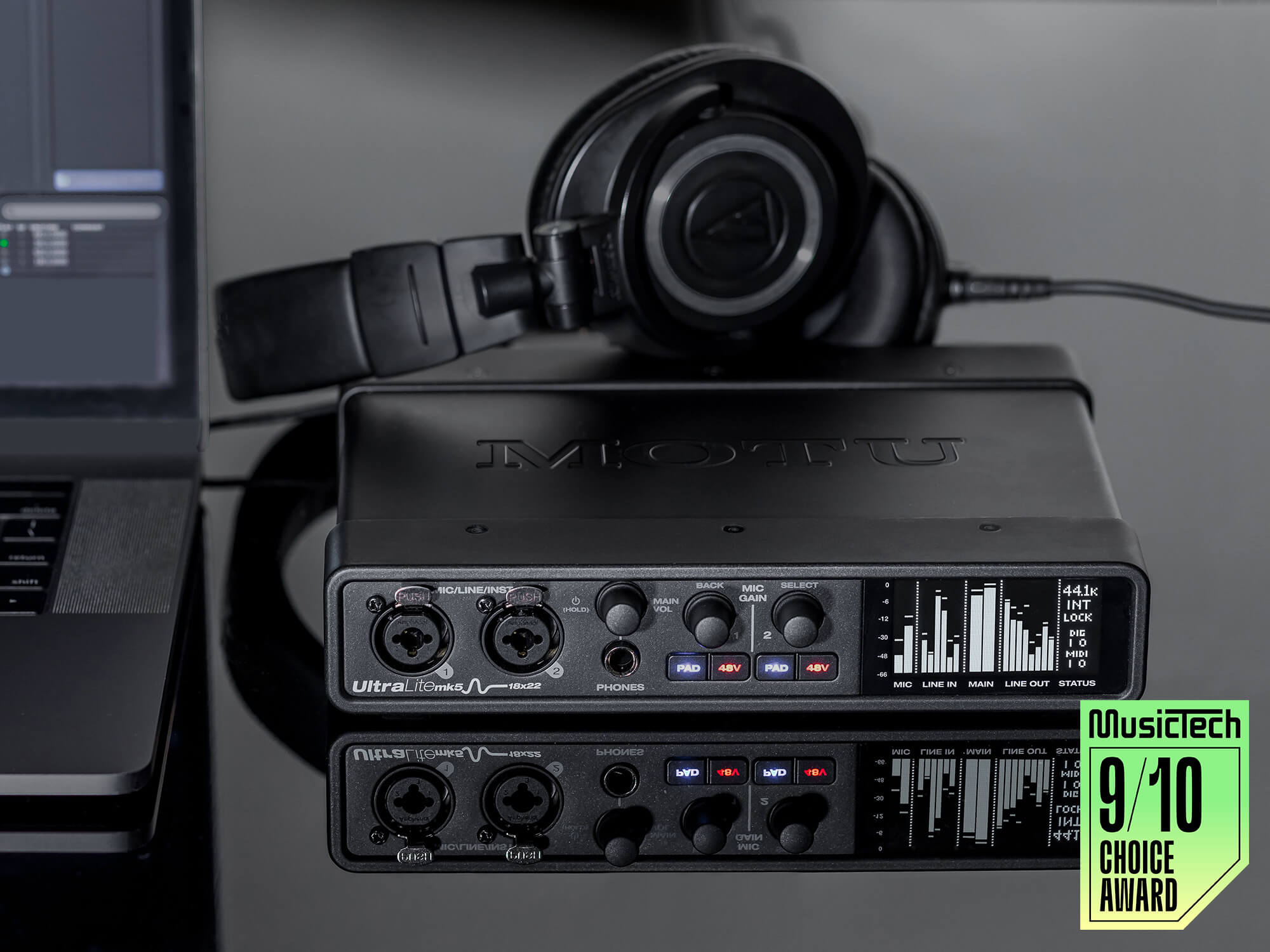
Review Overview
Our rating
9
Our verdict
⊕ High quality conversion
⊕ Ease of use and build quality
⊕ Handy onboard DSP including reverb
⊕ Fantastic metering
⊕ Class-leading value
⊖ CueMix limited
⊖ Lacks software control of the interface via WiFi
⊖ Fewer DSP functions on line ins/outs and none on digital ins/outs
In its half-rack format, MOTU’s UltraLite-mk5 USB-C interface offers impressive converter specs and is jam-packed with just about all the inputs and outputs you’ll need for a home or project studio, plus onboard DSP. With a form and feature set bearing close resemblance to the (similarly scarce) RME UCX II we looked at in 2022, the UltraLite’s cost is modest in comparison; all yours for around half the price of the RME.
- READ MORE: Austrian Audio OD5 & OC7 microphones review: Turning heads, but not without imperfections
What’s in the box?
The all-metal case feels reassuringly heavy and sturdy and the rotary controls are satisfyingly tactile, but the push switches are a little clicky. On the front, two combination sockets accept mic, line or instrument level. Although appearing limited at a glance, the product is aimed at those who might want a couple of preamps on board to get them started/for use on the go, and then supplement these with higher quality, external ones. Gain is applied digitally, for accurate level setting, assisted by push-button switches for phantom power and a sensitivity pad on each preamp. With a range of 74dB, there’s plenty of gain to go around.
We always prefer to have two headphone preamps, but the UltraLite-mk5 unfortunately has just one. The rotary encoder above it takes care of menu switching and output volume control. Usefully, when using multiple pairs of line outs to feed speakers – such as a surround setup – this knob can act as a master volume control once assigned. Aside from this, monitor controller type functions are severely limited – you’ll need to purchase a more accomplished interface to gain talkback, control room dim, and even a paltry mono sum button in the accompanying software mixer.
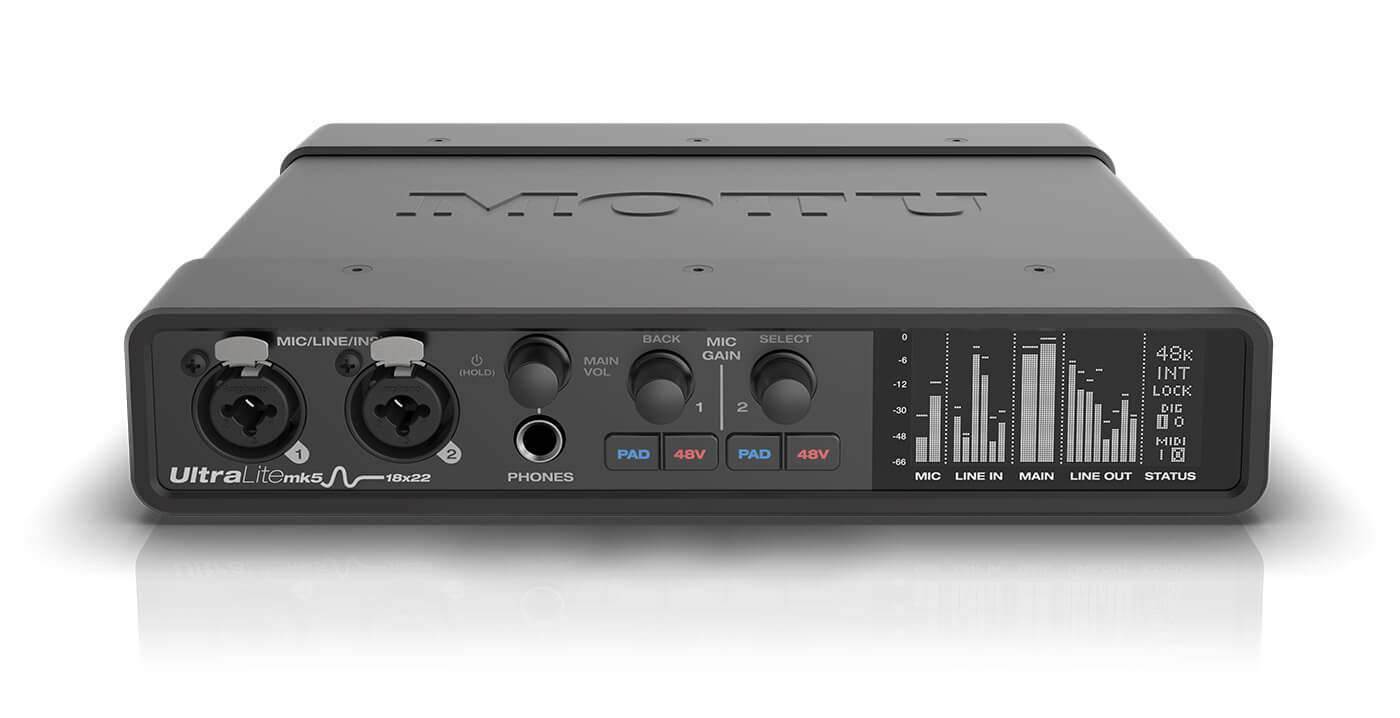
Bright monochrome meters display all analogue ins/outs simultaneously, but unfortunately not the digital signals. Arguably colder looking and not as jazzy as colour meters, these are hugely welcome and actually easier to read than those of the UCX II, which packs more inputs into its display.
Squeezed onto the back panel are six additional line ins, 10 line outs, S/PDIF, MIDI in/out, a socket for power supply and a single bank of ADAT ins/outs. The line level sockets feature a versatile, variable digital trim to make matching of levels with external gear a breeze, be it plugging in synths, headphone amps, patching in boutique mic preamps, or creating hardware inserts to send DAW tracks to analogue outboard. Nice!
While eight analogue ins/outs give a fair deal of scope for experimentation in the above areas, ADAT expandability opens up more possibilities of further ins and outs down the road. We’re pleased that MOTU hasn’t omitted ADAT out, as is the case with some interfaces of this size. You couldn’t wish for much more functionality at the price bracket, except for possibly wordclock and a second ADAT bank to run additional ins/outs at higher sample rates. In all honesty though, the manufacturer would struggle to fit anything more into the case.
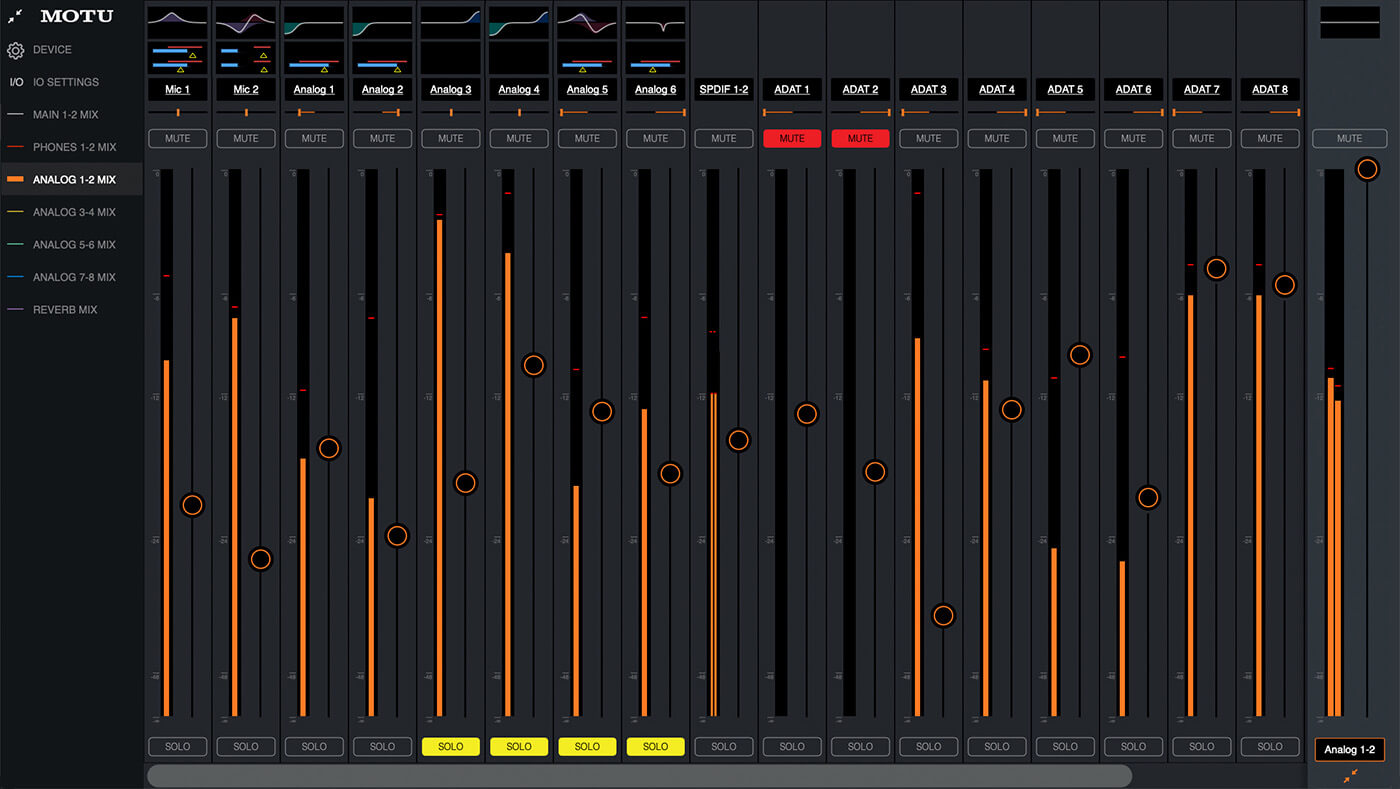
Cue the software
External control of the hardware comes courtesy of CueMix 5, a dumbed-down version of the Pro Audio Control web app used with MOTU’s more expensive interfaces. There are control panels for adjusting global device settings, updating firmware and saving convenient device presets, and a tabbed mixer takes care of the various mixes for studio monitoring and foldback.
You can access DSP by clicking on ‘slots’ above the relevant channel faders, but confusingly, some channels are more equal than others. All inputs can be routed to the reverb, however the onboard preamps have most to offer in terms of dynamics processing and EQ; all other types of channel meanwhile receive progressively slim pickings:
- Preamps: noise gate; compressor; four-band EQ
- Line ins: compressor; four-band EQ
- Line outs/headphone outs: three-band EQ
- Digital ins/outs: no dynamics processing or EQ
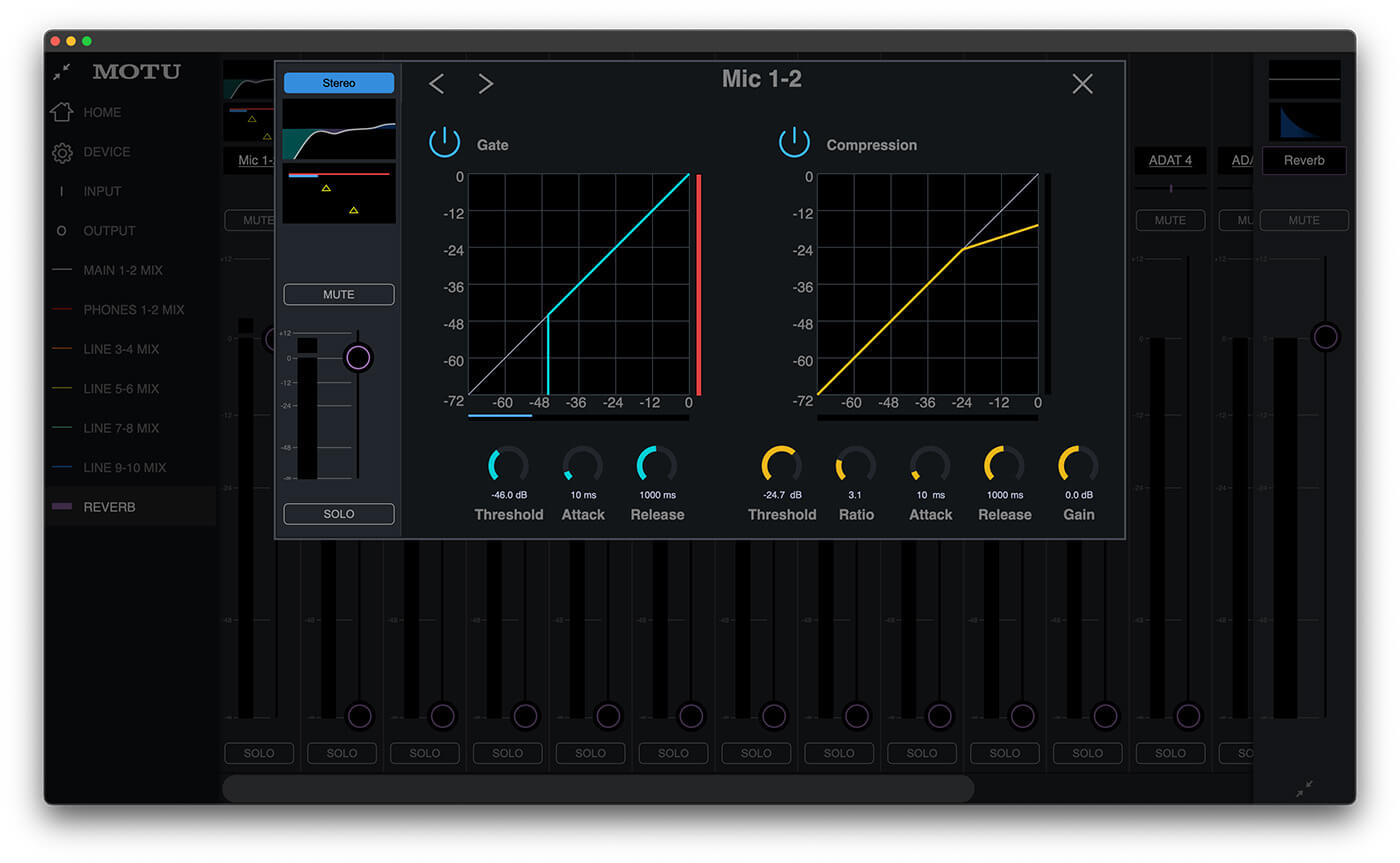
It’s great that the analogue ins/outs all benefit from DSP, however signals reaching the interface via ADAT – for instance, piped in from external 8-way mic preamps – are left out in the cold. And you wouldn’t necessarily be aware of the limitation before purchase without trawling masses of forum posts beforehand; disappointingly, neither the manual or promotional literature allude to this in any helpful way.
Away from CueMix, the software bundle is relatively slim, featuring a Lite version of MOTU’s Performer DAW, plus links to free sample packs. There’s nothing especially exciting to lure people in, but perhaps this doesn’t really matter as the UltraLite isn’t especially aimed towards beginners.

Ready to roll
Navigating input settings using hardware controls is intuitive and straightforward. The internal preamps are crisp and clean – perhaps a little on the brittle side compared to our outboard DAVs, and suffering the usual trade-offs of noise versus gain when dialling at higher ranges, but are perfectly usable.
Slotting EQ into the DSP gives a pleasing contour that means monitoring takes is far more enjoyable. And with enough high frequency damping – and at moderate send levels – the onboard reverb is just about bearable in the headphone mix. Built-in reverbs are invariably made to be CPU-light, and consequently too grainy for use, so this is a definite win. The flexibility to print the DSP – minus the reverb – onto the recorded signal is also a nice touch.
It’s just a shame that CueMix is frustratingly rough around the edges. For example, there’s not a quick way to bypass the entire EQ module in the DSP – each band needs to be toggled on/off – and the fixed resolution of the user interfaces results in annoying scrolling on a laptop screen. By comparison, RME’s equivalent TotalMix FX software runs far more smoothly, but is more complex to operate.

With the UltraLite, we miss the ability to control the interface via WiFi with a mobile app (without using MOTU’s suggested, fiddly OSC workaround), and we’d have really welcomed DSP for incoming ADAT digital signals so mics from external preamps could also enjoy a touch of EQ in foldback. (Yes – RME’s TotalMix FX has all these things).
Speaking of headphones, it’s simple to get a custom mix set up in CueMix and there’s plenty of level. As expected, the DAC sounds really classy to our ears when auditioning reference tracks, and when accessed via the line-ins, AD conversion sounds equally good.
MOTU’s UltraLite-mk5 is a mix of joyous pleasure and niggling background pain. Assuming you can live with its CueMix-related quirks and drawbacks, this highly capable and feature-rich interface represents a bargain proposition. If it looks to be the interface for you, grab one while you can!
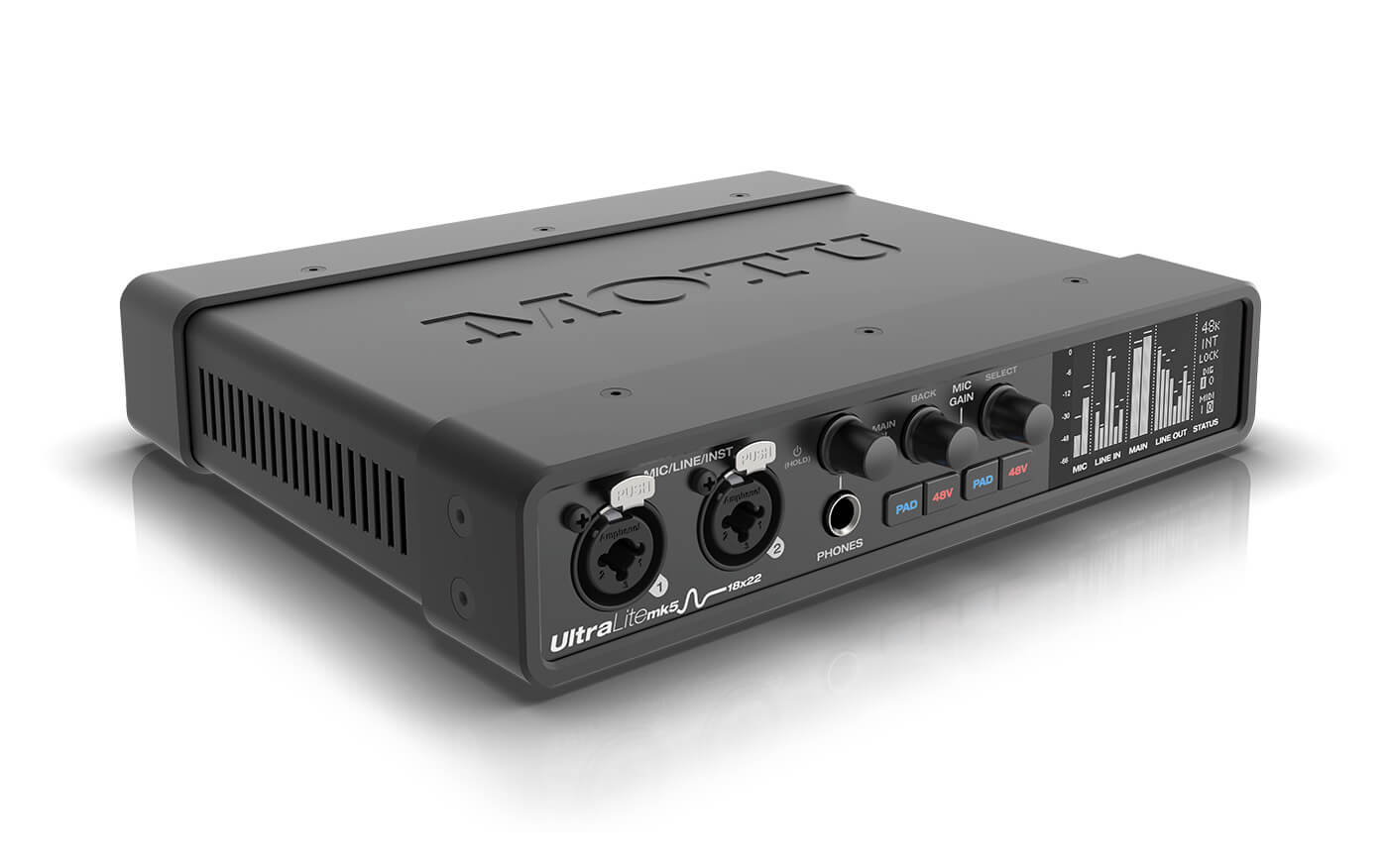
Key Features
- USB-C
- For Mac, Windows & iOS/iPad OS
- Sample rates up to 192kHz
- 125dB(A) dynamic range on line outputs
- Onboard DSP – EQ, dynamics and reverb
- Monochrome LED meters
- 2 combo mic/line/instrument inputs
- Digital gain (74dB range)
- 6 line inputs
- 10 line outs
- 1 headphone preamp
- Loopback
- S/PDIF in/out
- ADAT in/out
- MIDI in/out
- Comes with external PSU, USB-C cable, USB-A to USB-C cable, printed manual
- Rack mounting kits available separately
- £659 (street price)
- Contact MOTU
- Buy: Gear4music, GAK